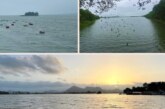 NEW DELHI: The Central groundwater Board has categorised groundwater in Delhi into four zones according to availability and quality of water and issued guidelines for managing them. It has also recommended the cessation of all extraction of groundwater from a 1km-zone on either side of Najafgarh drain and from landfill and industrial sites because of the water there being highly polluted.
NEW DELHI: The Central groundwater Board has categorised groundwater in Delhi into four zones according to availability and quality of water and issued guidelines for managing them. It has also recommended the cessation of all extraction of groundwater from a 1km-zone on either side of Najafgarh drain and from landfill and industrial sites because of the water there being highly polluted.
In its report called “Hydrogeological Framework and Groundwater Management Plan of NCT Delhi,” released recently, CGWB has recommended extraction in Zone 1 areas, where groundwater is available at a depth of less than 8 metres below the ground. However, the report also said that many areas in this zone had poor quality water and this should be used for salt-tolerant crops or blended with clean water for non-drinking purposes.
The board said extraction projects should not be allowed in areas with declining water level (zone III). These included Delhi Cantonment, Vasant Vihar, Hauz Khas, Kalkaji, Chanakyapuri, Connaught Place, Punjabi Bagh, Paharganj, Preet Vihar and Vivek Vihar. CGWB has said if pumping continued at the current rate here, it would result in saline water. It has recommended rainwater harvesting and use of tertiary treated waste water for recharge of these areas.
The report warned that overexploitation was not only depleting water resources, but turning groundwater saline. Of the 13,491 million cubic metres (MCM) of groundwater in Delhi, 10284 MCM, or 76%, was brackish or saline. Among affected areas were Darya Ganj, Saraswati Vihar, Punjabi Bagh, Najafgarh, Civil Lines, Defence Colony, and Delhi Cantonment. “Poor quality groundwater can be used for growing salt-tolerant crops like cotton, wheat, gaur, chickpea, soyabean, sugarcane and others,” the report advised.
As for places abutting the Najafgarh drain, the report stated that the “presence of heavy metals has been reported in groundwater along the drain. Therefore, groundwater in this zone is unsuitable for drinking and irrigation purposes…pesticides and bacteriological parameters have also been reported in isolated pockets. It is recommended that landfill sites should be selected after concluding hydrogeological surveys to minimise the risk of groundwater pollution”.
Shashank Shekhar, assistant professor of geology at Delhi University, who had conducted an independent study on the Najafgarh drain, pointed out, “Fluoride and even arsenic in groundwater in water samples of the Najafgarh drain can be attributed primarily to anthropogenic sources. Some heavy metals are, of course, found naturally in the environment, but they are not found in levels that are dangerous to human use. High nitrate contamination was also discovered in Timarpur, with fluoride levels above permissible limits in 20% of the samples.”
CGWB has identified a “potential aquifer zone” along the western Yamuna canal which can yield around 5 million gallons per day (MGD) of water (the city’s need is estimated to be 1,140 MGD by the 12th Five Year Approach Plan paper). The board also mapped tehsil-wise groundwater level trends between 2003 and 2013. Kalkaji tehsil showed the highest groundwater development at 277%, or much higher exploitation than the recharge capacity. It was followed by Vasant Vihar at 268%, Hauz Khas at 260% and Rajouri Garden at 232%.
Jayashree Nandi| tnn



